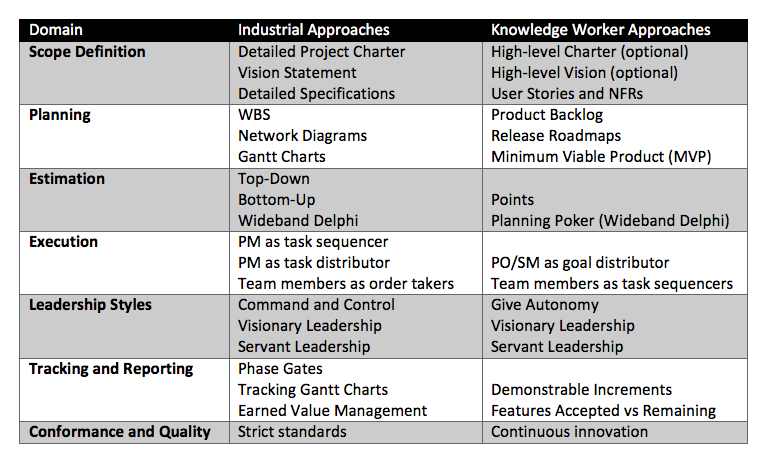We know old concepts that govern agriculture do not apply to industry. Engineers do not consult the weather or growing seasons before designing machinery. Yet many project managers who work in the knowledge worker domain still apply project management approaches developed for the industrial era.
This mismatch of approaches wastes effort and misses important new risks.
This article identifies the mismatch of applying industrial project management in today’s post-industrial marketplace. We first examine how to determine if your projects are: industrial, knowledge work, or hybrid. Then classify project management tools and techniques.
Fortunately, for every industrial focused approach there are modern knowledge worker equivalents. Using this information, we can apply the right tools for the job or at least identify the risks of mismatched projects and techniques.
How We Got Here
Work, like people, has evolved. Humans started out as nomadic hunter-gathers following the seasons and game. Then, when they discovered farming, they settled and built permanent home sites. This change was christened the Agricultural Revolution and heralded a huge shift for how people lived and worked.
Next came the Industrial Revolution. Farmers and craftsmen (craftspeople really) moved from distributed communities to live in expanding cities where the industrial mills and factories were booming. Again, this was a massive change for humanity. Schools focused on timekeeping, rigor, and repetition to prepare children to work in factories. Conformance to schedules and plans made the scaling of a workforce possible.
Concepts like Taylor’s Scientific Management provided tools for tackling big engineering endeavors and applying specialized labor. Progressive decomposition of work and detailed scheduling of tasks allowed complex projects to be planned and managed. Techniques like work breakdown structures, network diagrams, and Gantt charts were taught to project managers to tame and track engineering work.
These techniques work well for tangible, stable, and mostly predictable projects. As long as an organization has a history of building a similar product, then the gap to a new design or bigger scale can be reasonably estimated and planned for.
Difficulties arise when we try to use these approaches on intangible, unfamiliar, and new environments. Differences in understanding frequently occur when we lack physical reference points such as, “I want a wooden door like this one, but a foot taller.”
These differences result in more change requests, more reported defects, more uncertainties, and risks.
In novel, intangible environments, like software development or filmmaking, things rarely progress predictably enough to follow the “Plan the work, work the plan” mantra of industrial projects.
New technology evolution accelerates the rates of change. Demands to deliver faster worsen the situation.
Many of today’s projects fit this new breed of project that were christened Knowledge Work projects by Peter Drucker.
Also, many traditional industrial projects have been automated or offshored to cheaper labor markets. This leaves a higher proportion of new projects developing largely invisible, intangible, difficult to reference, products, and services—knowledge work.
I am not suggesting all project work has changed. Just as we still have farmers—and hopefully always will—we still have traditional industry and industrial projects. So, while not all work has changed, the fastest growing segment has.
The increasing role of software in business also means a larger proportion of projects have at least some knowledge work component.
To help diagnose your project types, answer the following questions about the nature of projects you execute.

If you scored more on the left-hand side of the table, you are engaged in mainly industrial type projects. This is good news for reliable execution: traditional project management tools and techniques should serve you well.
If you scored more on the right-hand side, you are firmly in the knowledge worker domain. You should move from industrial project management approaches and adopt knowledge worker ones.
If you scored equally from each column, you are in a hybrid environment. Here you likely need to draw on a combination of approaches to be successful.
New Territory, New Tools
The tools and approaches of the knowledge worker revolution address the complexity and ambiguity that accompany these projects. Let’s dig deeper to understand the characteristics and appreciate post-industrial project management techniques.
Knowledge work projects bring subject matter experts together to collaborate on new and unique products and services. This might involve scientists, teachers, doctors, lawyers, software developers, or web designers working with the business to build something new.
Each of these groups have specialized knowledge, typically no single person knows everything needed to complete the project. What is being created is new or sufficiently different to the sponsoring organization that previous project’s plans and estimates are not particularly useful to predict progress.
Compared to traditional, predictable industrial engineering, complexity, uncertainty, risk and change rates seem very high. Without tangible reference work, it is necessary to use an iterative-and-incremental approach to determine fitness-for-business-purpose. Teams could attempt to analyze and predict all features and functions, but often initial use uncovers additional opportunities and requirements.
Trying to explain the nuances of iTunes or Netflix to someone who has never seen anything like it before is difficult. Incremental trial proves faster and more useful than speculative big-design-upfront that cannot anticipate every interaction with user behavior or linked systems.
Tools rooted in big-design-upfront, predictable decomposition of tasks, linear progression of work, etc. do not work well in these environments. These include detailed requirements documents, work breakdown structures, network diagrams, Gantt Charts, and earned value management.
That’s not to say you cannot use these approaches, just that there are alternatives that better handle the high rates of change and uncertainty.
We still need to record requirements and the use of product backlogs containing user stories makes it easier to reprioritize when changes occur. We still need to break down work and help the business decide how to best divide a big project. Instead of looking at complex architectural component diagrams, the business can make better delivery decisions by using release roadmaps, and features lists.
In the face of high rates of change, averaging delivery rates to-date can give more reliable projections than estimating the durations for planned activities. Likewise, when work is creative or R&D type in nature, we often get nonlinear progression – in other words some things go faster than anticipated while other items take longer.
Approaches like earned value management that extrapolate performance to-date to predict likely completion schedules and costs assume a linear progression of work. Instead, tracking progress based on tested, accepted features only is a more reliable predictor of true progress.

Traditional project management approaches are built on the realities of predictable, industrial work. Knowledge work projects defy these traditional laws of physics since they operate outside the physical domain.
Instead they deal with ideas, people, and collaboration, which are intangible. Traditional resource management suggests if we are digging a ditch with 10 people, then adding 10 more people would complete the task in half the time.
Fred Brooks’ law of software development tells us that adding more people to a project that is already late will increase its duration.
Traditional project management approaches are not flawed or broken. They work great for the industrial world. In these environments, the best way to run a project is with detailed upfront planning, clearly articulated tasks and schedules, and careful granular tracking.
However, if your results from earlier indicate a hybrid or knowledge work environment then use the appropriate tools.
Trying to use the recommendations from a previous work era is akin to waiting for a full moon before starting your kitchen reno. At best you are adding wasted activities and at worst you are ignoring the realities of your environment that carry the risk of overruns and failure.







